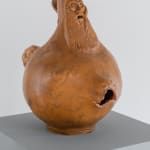


Serena Korda
Terracotta Hole, 2015
Ceramic Stoneware and Glaze
45 x 35 x 35 cm
Copyright The Artist
Further images
The Jug Choir: Ectoplasmic Variations is a group performance in which members of the public sing into Korda’s own hand-made ceramic artworks. With ceramic vessels bearing the faces of bearded...
The Jug Choir: Ectoplasmic Variations is a group performance in which members of the public sing into Korda’s own hand-made ceramic artworks.
With ceramic vessels bearing the faces of bearded men, Korda references the Bellarmine jugs of the sixteenth century that were used as common household objects. During the witch hunts of the seventeenth century, these jugs were transformed into ‘Witch Bottes’, a form of sympathetic magic used to ward off evil. A kind of voodoo ensued as the body of the male vessel was filled with urine, bent nails and votive cloth hearts, hoping to cause pain to any ‘witch’ that posed a threat.
Korda uses the ‘Witch Bottles’ as a vehicle to explore notions of gender and hysteria through the lens of war. She invites you to listen as the vessels are activated by performers in a way that explores the materiality of object and sound, and encourages questions of how ritual is embedded in acts of violence.
With ceramic vessels bearing the faces of bearded men, Korda references the Bellarmine jugs of the sixteenth century that were used as common household objects. During the witch hunts of the seventeenth century, these jugs were transformed into ‘Witch Bottes’, a form of sympathetic magic used to ward off evil. A kind of voodoo ensued as the body of the male vessel was filled with urine, bent nails and votive cloth hearts, hoping to cause pain to any ‘witch’ that posed a threat.
Korda uses the ‘Witch Bottles’ as a vehicle to explore notions of gender and hysteria through the lens of war. She invites you to listen as the vessels are activated by performers in a way that explores the materiality of object and sound, and encourages questions of how ritual is embedded in acts of violence.


